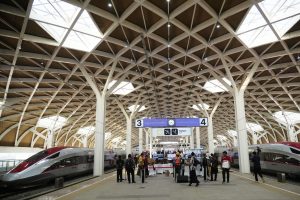China’s infrastructure funding promises to Southeast Asia are falling short by more than $50 billion, according to a new report, with megaprojects undertaken under the Belt and Road Initiative (BRI) stagnating or failing due to poor planning, the global clean energy transition, and political lurches in recipient countries.
The report, released today by Sydney’s Lowy Institute, found that China remains “easily” the region’s largest infrastructure funder, involved in 24 out of the region’s 34 infrastructure megaprojects, which are defined as those costing $1 billion or more. At the same time, “there is a significant gap between China’s promises and its implementation, between what Beijing commits to and what it delivers.”
According to the Lowy report, this shortfall totals more than $50 billion, more than half of which is “allocated to projects that have been cancelled, downsized, or otherwise seem unlikely to proceed.” Currently, only 35 percent of China’s infrastructure projects have been seen through to completion, compared to 64 percent for Japan and 53 percent for the Asian Development Bank (ADB).
Of the 24 megaprojects mentioned above, eight worth about $16 billion have been completed, including high-profile railway projects in Indonesia and Laos. Another eight, worth $35 billion, are on track, though two have been “substantially downsized.” Meanwhile, “five projects worth $21 billion have been cancelled, while another three projects worth $5 billion seem unlikely to proceed.”
The report puts this funding gap down to three factors. The first is China’s “almost exclusive focus on financing ambitious megaprojects especially prone to problems and delays.” Impressive megaprojects have always been a hallmark of Beijing’s BRI, but the greater cost and complexity of these projects means likely that they are more likely to run into political or financial hurdles.
The second and related factor is domestic political change in recipient countries, by which turns large-scale infrastructure projects agreed by one government have later been canceled or downsized by its successor. Among the examples given are the East Coast Rail Link in peninsular Malaysia, which was agreed by Prime Minister Najib Razak’s administration in 2016, suspended and renegotiated after the election of Prime Minister Mahathir Mohamad in 2018. (The rail project is now slated to go ahead more or less in its original form.)
Similarly, in the Philippines, the government led by President Ferdinand Marcos Jr. dropped Chinese funding for two prominent BRI projects, the PNR Bicol line and the Mindanao Railway Project. Meanwhile, in Myanmar, the election of Aung San Suu Kyi’s National League for Democracy in 2015 led to the scaling back and renegotiation of several projects, including a large port project at Kyaukphyu in Rakhine State. The military coup of 2021 and the conflict that has ensued will also “undoubtedly present ongoing challenges” for the implementation of the various projects that Beijing is pursuing under the China-Myanmar Economic Corridor, a sub-pillar of the BRI.
The two other factors adduced in the Lowy report are China’s generally weak stakeholder consultation, and the global energy transition, which has led to the downsizing or abandonment of fossil fuel projects.
Whether this funding shortfall is ultimately much of a problem for Beijing remains unclear. Pressing ahead with financially unviable or politically unpopular projects would seem to pose much greater risks to its influence than letting some fall by the wayside, especially given the vast lines of credit that Chinese state banks are extending to support them.
It can also be argued that much of this simply reflects the broader approach of the Chinese state to large-scale initiatives, in which eye-catching announcements are made before – rather than after – the details have been worked out. In his book “The Souls of China,” Ian Johnson described China as “the land of soft openings. Projects are first announced to big fanfare, structures erected as declarations of intent, and only then filled with content.” How much of this is a feature rather than a bug of the BRI in Southeast Asia is open to debate, but it has always been clear that the initiative is a work in progress, with ill-defined content and scope, and that the overweening self-confidence of its initial phase would lead to
In any event, even taking these shortfalls into account, Beijing remains by far the largest infrastructure funder in Southeast Asia. The Lowy report stated that if China simply maintains its current implementation rate for infrastructure projects (35 percent) it is likely to disburse an additional $19 billion in Southeast Asia in the coming years. Combining it with the $30 billion already disbursed in the region, this brings it to a total of $49 billion, “still more than twice the cumulative infrastructure disbursements” of Japan ($22 billion) and the ADB ($11 billion).
And there are also signs that the Chinese government is beginning to learn some lessons from the first decade of the BRI. Amid a broader decline in the number of Chinese infrastructure deals, Beijing is “learning from experience, shifting away from megaprojects towards smaller ones, and lifting its focus on risk management, integrity and compliance, worker safety, project preparation, financial due diligence, and higher environmental and social standards.”
“With an eye to the future,” the report concludes, “it becomes clear that by virtue of the scale of China’s ambition, even a partially unfulfilled Chinese development program would provide more than that of any other international partner involved in Southeast Asia.” With the BRI likely to continue playing a prominent role in fulfilling Southeast Asia’s infrastructure needs, the perhaps more pressing question is whether and how China’s rivals, including Japan, the United States, and Australia, can keep pace.

































